The business landscape is ever-evolving, and to stay ahead of the curve, companies must adapt and innovate continuously. Process reengineering is a powerful tool that enables organizations to streamline operations, maximize efficiency, and drive growth. By implementing successful process reengineering strategies, businesses can revolutionize their operations and achieve sustainable success in today's competitive market.
Process Mapping
One essential step in process reengineering is mapping out current workflows to identify inefficiencies and bottlenecks. By visually representing the entire process from start to finish, companies can pinpoint areas for improvement and redesign processes for optimal efficiency. Fact: According to a study by McKinsey & Company, companies that prioritize process mapping experience a 30% increase in operational efficiency.
Technology Integration
Leveraging technology is crucial for successful process reengineering. Companies can implement automation tools, workflow software, and analytics solutions to streamline operations, enhance decision-making, and drive digital transformation. By integrating technology effectively, businesses can achieve significant cost savings and operational improvements. Fact: A survey by Deloitte found that 72% of executives believe that technology integration is essential for successful process reengineering.
Cross-Functional Collaboration
Collaboration across departments is key to implementing successful process reengineering strategies. By involving employees from different functions in the redesign process, companies can gain valuable insights, foster innovation, and ensure buy-in from all stakeholders. Cross-functional collaboration promotes a holistic approach to process improvement and drives organizational alignment. Fact: Research conducted by Harvard Business Review shows that companies with strong cross-functional collaboration are 20% more likely to achieve successful process reengineering.
Continuous Improvement
Process reengineering is an ongoing journey, not a one-time project. Companies should establish a culture of continuous improvement by regularly monitoring performance metrics, gathering feedback from employees and customers, and adapting processes to changing market dynamics. By embracing a mindset of continuous improvement, businesses can stay agile, responsive, and competitive in the long run. Fact: A study by the American Society for Quality (ASQ) found that companies that prioritize continuous improvement achieve a 70% higher success rate in process reengineering initiatives.
Employee Training and Development
Investing in employee training and development is critical for the successful implementation of process reengineering strategies. Companies should provide employees with the necessary skills, knowledge, and resources to adapt to new processes, technologies, and ways of working. By empowering employees to embrace change and participate in process redesign, businesses can drive engagement, morale, and performance. Fact: According to a report by the Society for Human Resource Management (SHRM), companies that invest in employee training experience a 24% increase in productivity.
In conclusion, by embracing process reengineering and implementing successful strategies, businesses can transform their operations, drive efficiency, and achieve sustainable growth. Through process mapping, technology integration, cross-functional collaboration, continuous improvement, and employee training, companies can revolutionize their business practices and stay ahead in today's dynamic marketplace. Process reengineering is not just about optimizing workflows; it is about creating a culture of innovation, agility, and excellence that propels businesses towards long-term success.
 (Image via
(Image via





